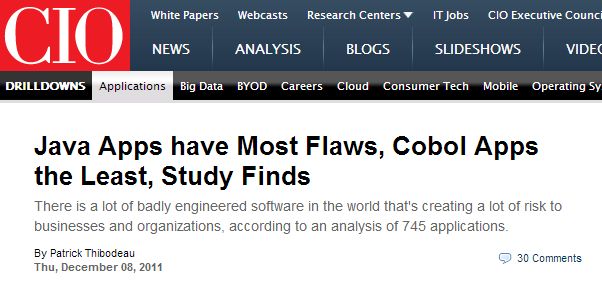Oh great, how did you do this, what language?
A good friend of mine had a question to me today. He had a simple text file with blocks of various number of lines that he would like to be sorted by a string identifiable in each blocks header line.
The file itself was about 22,000 lines, to much for manual sorting. He asked me if I would have an idea for a tool or software like Textpad to do this job.
I just told him I can make this happen in an hour and then he can check results and if it fulfils his requirements. We agreed to this.
After just 15 minutes I sent the file back to him. He tested quickly and figured out it still has some curious things like being shown before . This was just a forgotten UPPER vs. lower case issue. Fixed and sent back a new file in another minute. File looked great then.
While I am writing the friend is keen to get the information on how I did this. He is a real good programmer; he has all the tools I am having. But sometimes it is really beneficial to think about the good old tools that you have somewhere around. Yes, we have text files, but this must not require modern tools like Textpad to handle such files efficiently.
I used a simple 120 lines COBOL code and a small JCL to run the job. 105 of the lines were just COPY & PASTE and the rest was quickly typed in. The JCL was copied and only the file names had to be added. With some tricks we probably can write the same COBOL code in less then 50 lines. It would still do the same damned good job but it would not look that easy it is looking right now.
The CODE:
###############################################################################
###############################################################################
###############################################################################
******************************************************************
* *
* I D E N T I F I C A T I O N DIVISON *
* *
******************************************************************
IDENTIFICATION DIVISION.
PROGRAM-ID. TstSRT04.
******************************************************************
* *
* E N V I R O N M E N T DIVISON *
* *
******************************************************************
ENVIRONMENT DIVISION.
******************************************************************
* C O N F I G U R A T I O N SECTION *
******************************************************************
CONFIGURATION SECTION.
SPECIAL-NAMES.
DECIMAL-POINT is COMMA.
/*****************************************************************
* I N P U T - O U T P U T SECTION *
******************************************************************
INPUT-OUTPUT SECTION.
FILE-CONTROL.
SELECT I1
ASSIGN TO I1
ORGANIZATION IS SEQUENTIAL SARF
FILE STATUS IS STAT.
SELECT O1
ASSIGN TO O1
ORGANIZATION IS SEQUENTIAL SARF
FILE STATUS IS STAT.
SELECT S1
ASSIGN TO S1
FILE STATUS IS STAT.
/
******************************************************************
* *
* D A T A DIVISON *
* *
******************************************************************
DATA DIVISION.
******************************************************************
* F I L E SECTION *
******************************************************************
FILE SECTION.
FD I1.
01 I1Rec PIC X(500).
FD O1.
01 O1Rec PIC X(500).
SD S1.
01 S1Rec.
05 S1Key.
10 S1KeyID PIC X(100).
10 S1KeyCnt PIC 9(010).
05 S1Data PIC X(500).
******************************************************************
* W O R K I N G - S T O R A G E SECTION *
******************************************************************
WORKING-STORAGE SECTION.
01 WorkFlds.
05 wSrtKeyID PIC X(100).
05 wSrtKeyCnt PIC 9(010).
05 tLgI PIC 9(004) COMP-5.
******************************************************************
* global workfields used anywhere in the pgm *
******************************************************************
05 STAT PIC X(002).
******************************************************************
* *
* P R O C E D U R E DIVISON *
* *
******************************************************************
PROCEDURE DIVISION.
******************************************************************
* A - M a i n SECTION *
******************************************************************
A-Main SECTION.
PERFORM C-Sort1
STOP RUN
.
C-Sort1 SECTION.
OPEN INPUT I1
OPEN OUTPUT O1
MOVE LOW-VALUE TO wSrtKeyID
MOVE ZERO TO wSrtKeyCnt
SORT S1 ascending key S1Key
INPUT PROCEDURE IPROC
OUTPUT PROCEDURE OPROC
CLOSE I1
CLOSE O1
.
IPROC SECTION.
IPROC-Loop.
READ I1 next
at end EXIT SECTION
end-read
IF I1Rec(01:17) = "/****** Object: "
MOVE I1Rec(18:) TO wSrtKeyID
MOVE ZERO TO wSrtKeyCnt
MOVE length of wSrtKeyID TO tLgI
CALL "YUCASE01" using wSrtKeyID, tLgI
end-if
ADD 1 TO wSrtKeyCnt
MOVE wSrtKeyID TO S1KeyId
MOVE wSrtKeyCnt TO S1KeyCnt
MOVE I1Rec TO S1Data
RELEASE S1Rec
GO IPROC-Loop
.
OPROC SECTION.
OPROC-Loop.
RETURN S1
at end EXIT SECTION
end-return
MOVE S1Data TO O1Rec
WRITE O1Rec
GO OPROC-Loop
.
*-eof-*
###############################################################################
###############################################################################
###############################################################################
THE JOB CONTROL:
###############################################################################
###############################################################################
###############################################################################
stp TSTSRT04;
asg I1 C:\TEMP\SPS_TABLES_082311_NOTSORTED.TXT;
asg O1 C:\TEMP\SPS_TABLES_082311_SORTED.TXT;
def O1 StripSpace=Yes;
endstep;
done:
*eof
###############################################################################
###############################################################################
###############################################################################
The JOB EXECUTION:
###############################################################################
###############################################################################
###############################################################################

###############################################################################
###############################################################################
###############################################################################
Job ran in less then a second to sort all the blocks in the 22,000 lines.
COBOL can help you always. Just have the right ideas. And of course, you should have these at the right times. 🙂



 I am wondering how one can help here. Myself I am writing in this ‘un-cool’ and ‘dead’ language since 25+ years. Using the Micro Focus Workbench I started writing Mainframe emulators. A complete Toolset to migrate files, run Batch processes and Emulating a whole Transactional System, all written in this ‘un-cool’ Language. How can we make students understand that COBOL is not dead? How can we make Teachers understanding that they have to teach even so called ‘dead’ languages? Let’s start the Discussion! You, yes you, who just read it, play the Ball. Let’s talk. Wants to read the full Article? Here you go.
I am wondering how one can help here. Myself I am writing in this ‘un-cool’ and ‘dead’ language since 25+ years. Using the Micro Focus Workbench I started writing Mainframe emulators. A complete Toolset to migrate files, run Batch processes and Emulating a whole Transactional System, all written in this ‘un-cool’ Language. How can we make students understand that COBOL is not dead? How can we make Teachers understanding that they have to teach even so called ‘dead’ languages? Let’s start the Discussion! You, yes you, who just read it, play the Ball. Let’s talk. Wants to read the full Article? Here you go.
